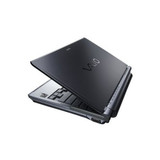Sony Vaio VGN-TXN27N
Especificaciones de Portátil(es)

Price comparison
Promedio de 1 puntuaciones (de 1 análisis)
Análisis para el Sony Vaio VGN-TXN27N
Origen: notebookforums.com
 EN→ES Archive.org version
EN→ES Archive.org versionThis review is a fun one to write because I have personally been using the Sony Vaio TXN27N for months as one of my main computers. It’s always great to be able to report back after using a system for some time rather than a standard testing period because I think it makes for a more complete review.
The market for ultraportables (sub 4-pound notebooks) is so hot right now and it won't be slowing down any time soon. Technology is advancing rapidly, and more and more power is getting put inside smaller and smaller packages. In fact, a June 12 report from IDC that found that shipments of mobile and ultraportable notebooks grew 28 percent in the second quarter of 2007, compared with the second quarter of 2006. That’s huge.
While this tiny laptop isn’t perfect, and there is certainly room for improvement, if you are in the market for a very portable laptop with the potential for a ton of battery life, the Sony TX (and new TZ series) is a great choice.
(von 10): 8, Leistung 5, Display 8, Mobilität 10, Verarbeitung 8
Análisis del Usuario, disponible online, largo, Fecha: 08/03/2007
Puntuación: Puntuación total: 80% rendimiento: 50% pantalla: 80% movilidad: 100% procesamiento: 80%
Comentario
Intel Graphics Media Accelerator (GMA) 950: Intel Graphics Media Accelerator 950 es un chip de video integrado (incorporado) en Mobile Intel 945GM chipset. Es una versión con frecuencia más rápida del GMA 900.
Muchos juegos son difícilmente ejecutables con estos adaptadores gráficos o se ejecutan de manera muy lenta.
>> Más información puede ser encontrada en nuestra comparación de tarjetas gráficas moviles y la lista de benchmarks.
Intel Core Solo: La versión simple del Core Duo y successor del Intel Pentium M; también existe menor consumo de energia en comparación a la Pentium M (máximo 27 Watts), debido a la reducción de 65nm a lo ancho de la estructura; el rendimiento es comparable con la frecuencia equivalente de la Pentium M (de algún modo mas rápido debido a algunas mejoras).
U1500:
>> Más información puede ser encontrada en nuestra comparación de procesadores móviles.







